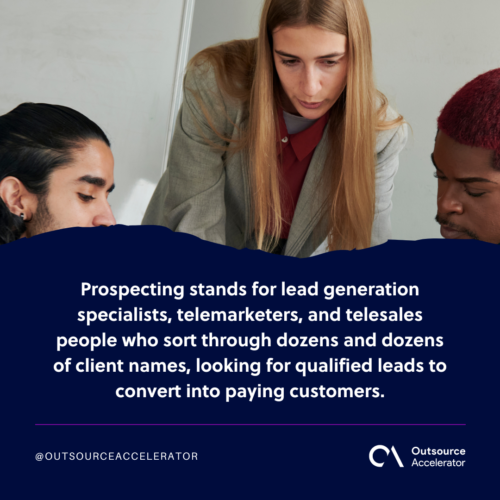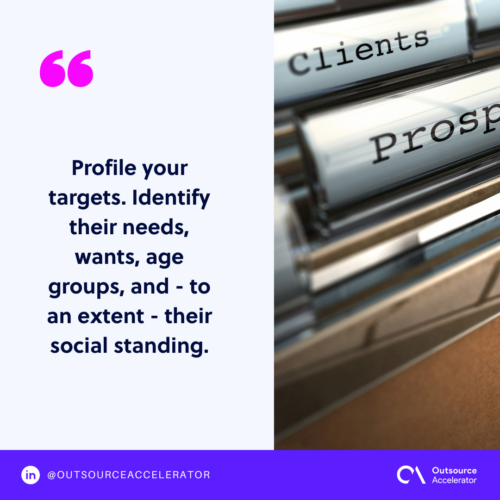What are sales prospecting tools and what do they do

Telemarketers and salespeople use sales prospecting tools to make their days efficient and more productive. These tools can be native applications, web-based tools, strategies, or just good old-fashioned skills.
These tools are developed to help you adapt, keep up, and accomplish tasks throughout your workday. Finding out what works best for your sales team is a journey that everyone can enjoy.
What is prospecting?
The word prospecting came from old towns wherein miners would visually inspect creek beds, shallow river shores, and rock formations for gold. They often wash away the dirt and debris to find nuggets and bits that were hidden from plain sight.
Today, prospecting no longer means sifting through dirt. It now stands for lead generation specialists, telemarketers, and telesales people who sort through dozens and dozens of client names, looking for qualified leads to convert into paying customers.

Can I prospect for free?
Even without paid tools, you can still connect with your client list, albeit with some challenges. But what’s work without little hardships, right?
To prospect for free, you have to invest time, effort, and energy in coming up with various strategies to connect with your prospective clients. One of the most basic ways to do this is to connect with them online.
For instance, LinkedIn is your best bet when working with B2B clients. With B2C clients, emails are your strongest weapon.
Best prospecting tools in 2021
Linkedin Sales Navigator
Status: Paid ($65/month)
Looking to broaden your network and formally connect with more prospects? The LinkedIn Sales Navigator is your best bet. There’s no doubt that LinkedIn is the biggest social connecting platform when it comes to professionals in every field imaginable out there.
Clutch.co
Status: Free
Clutch.co focuses on collecting and listing all the known information about companies and businesses all around the world. Of course, you can narrow down your list with their tools—starting with their cities, countries, and industries.
Hunter.io
Status: Free (Limited to 100 emails, starts at $39/month)
This nifty little Google Chrome extension works as an email scraper. The platform lists all the possible email combinations a company has. It shows an indicator of whether they’re more likely to answer an email or not.
Skrapp
Status: Free (Limited to 100 emails, starts at $49/month)
Similar to Hunter.io, Skrapp is an email and lead scraper—with a twist. It lists all the emails and connects the valid ones to a LinkedIn account, verifying email address’ validity and active status. Like its counterpart, it runs as a browser extension as well.
Bonus valid email tester: MailTester
Status: Free
Still not sure if the emails of your prospects are active? Let MailTester do its job.
Don’t waste your time crafting a personalized email for it to just bounce back at you. This tool checks the status of your prospect’s email, sending a short report if they’re valid or not.
What are the best prospecting techniques?
The best prospecting techniques are a mix of both technical and personal practices. From organizing your prospect list by using software to sending a well-thought-out personalized email, the best way to connect with them is to show the human behind the campaign.
Book in prospects
On a tight schedule? Let prospects know what days work for you so you can agree on the best time and meet halfway.
By booking in prospects, they’ll feel as though you’re valuing both your times for the meeting. It’s not just about the business you want to build up connections too.
Warm calling
Cold calling has a poor reputation. It leaves a bad impression on prospects. Ideally, it’s better to connect with them way before making that first call.
Warm calling generally makes people more open to your call. They know what and who to expect. Setting up a schedule for an initial call implies that you are genuinely trying to get to know them.
Keep in mind that a sale can’t be closed by the first couple of calls, but it’s better than getting hung up on. Unplanned calls catch people off guard, making them resistant to picking up unknown callers, even if it’s an opportunity.
Define your target buyers
Profile your targets. Identify their needs, wants, age groups, and – to an extent – their social standing. Cater your products to the right demographic and watch your revenue go up. Try to make your campaigns as organic as possible, while checking all the boxes on your demographic chart.

Expand your network
Build up your network. Join in on seminars, talks, summits, and even open meets to expand your network and your client list. This will pay off in time, especially if they deem the relationship you’re developing to be mutually beneficial.
For now, since we’re all still reeling from the effects of the pandemic, you can take advantage of webinars and your LinkedIn network to expand your circle.
Build meaningful relationships
But what if the relationship isn’t mutually beneficial? Your new leads might change their minds, but it’s also likely that they will introduce you to another prospect. In business, relationships are important. It’s wise not to burn bridges unless the occasion calls for it.
Redefine your skills
This is why upskilling and continuous learning are big trends for professionals and experts in every field.
With everything growing at such a fast pace, it’s only right that you keep up. A handful of programs a decade from now will be outdated, especially if the developers did not update it to accommodate technological growth.
What to do if your client keeps saying no
Hearing “no” is never easy, especially when you put a lot of effort and time into presentations and meetings. Put yourself in your prospect’s shoes and try to understand the circumstances that lead them to say no to you.
Listen to their objections
They may have other opportunities on hand. Maybe it’s a personal reason they chose against making the transaction. Don’t take their objections personally. Remember that sometimes, a sale just can’t be closed.
Make a compromise
If it wasn’t a hard no, but there’s a lot of hesitation, offer a compromise. Meet them in the middle and see if that works best for either of you. Let your final offer do the talking, then set up another check-in meeting.
Let it go
Sometimes, letting go of a lead is the best thing to do. Keep in mind that if you did your job right and the client was respectful of both your time, no bridges need burning. Who knows, maybe they’ll think of you and pick up another conversation once they encounter a need you can solve for them? After all, when a door closes, windows stay open.







 Independent
Independent




